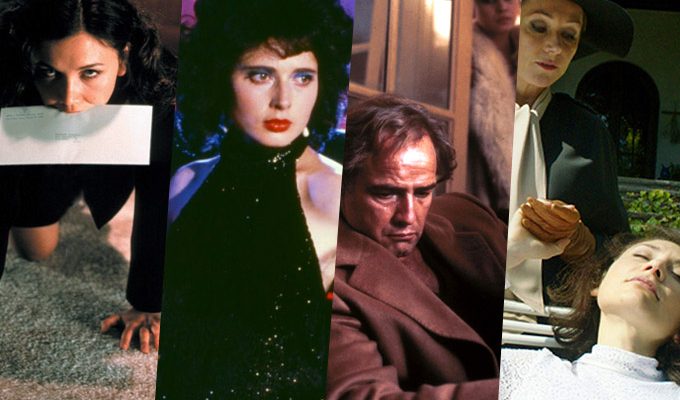“Story Of O” (1975)
Published in 1954, Anne Declos’ Marquis de Sade-influenced novel “Story Of O” (published under the nom de plume Pauline Reage) was one of the most important literary works in introducing BDSM to a wider audience —as a literary phenomenon, it was inevitable that the book would make it to the screen at some point. “Wages Of Fear” and “Les Diaboliques” helmer Henri-Georges Clouzot unsuccessfully attempted to mount an adaptation at one point, but it eventually reached the screen thanks to “Emmanuelle” director Just Jaeckin in 1975. It’s largely plot-free, involving a young woman called O (Corinne Cleary) whose lover Rene (Udo Kier) brings her to a chateau to be initiated in the world of sadomasochism by his step-brother Sir Stephen (Anthony Steel). It’s a clear forerunner to ‘Fifty Shades,’ though the exploits are a fair bit more hardcore and shares many of the same dramatic weaknesses. If your inclinations line up with the film’s ensemble, there might be some allure (though the presence of Kier is, frankly a little off-putting), but the characters are so blank, the material so repetitive, and the direction so cheap and shoddy (and often unintentionally funny, like the LOL-tastic owl mask that O wears at the end) that it’s typically hard for the non-inclined to get anything out of it. Still, the whole thing’s on YouTube, though the film was banned in the UK until 2000.
“In the Realm Of The Senses” (1976)
It might feel like unsimulated sex scenes in serious arthouse cinema is a relatively recent invention in light of films like “The Idiots,” “9 Songs,” “The Brown Bunny,” “Shortbus” and “Nymphomaniac.” But “In The Realm Of The Senses,” from the late Japanese director Nagisa Oshima, caused significant fuss four decades ago. Technically a French production (Japanese laws only allowed the explicit film to be made as a foreign production), it’s set in Tokyo in 1936, as the owner of a hotel (Tatsuya Fuji) begins a boundary-pushing relationship with a maid (Eiko Matsuda) who used to be a prostitute. Based loosely on a real-life event involving a woman named Sada Abe and with the Japanese title “Ai No Corrida” (which translates literally as “Bullfight Of Love,” which is rather more fitting), it’s a portrait of an all-consuming love affair. But while it has political (and particularly in the context of the others films on this list, feminist) overtones, this film manages to effectively mix the sensual and the disturbing. Though obviously there’s more of the latter in the film’s famous finale, in which Fuji is strangled to death mid-coitus and Matsuda then cuts his penis off. It’s a tremendous example of using real sex as a storytelling technique rather than as pure titillation.
 “Tightrope” (1984)
“Tightrope” (1984)
It’s quite hard to reconcile the somewhat beige, Oscar-magnet, hit-the-golf-course-by-five Clint Eastwood of “Invictus,” “Hereafter,” “Changeling” and “American Sniper” with the guy who could only a few decades earlier appear in a film like Richard Tuggle’s “Tightrope.” A surprisingly racy police procedural/character study, this film functions as if Dirty Harry was played by Michael Fassbender’s character from “Shame.” Eastwood plays New Orleans detective Wes Block, who is tracking a rapist/murderer preying on sex workers, the twist being that Block’s own sexual proclivities aren’t all that far from the killer’s own, complete with mild bondage. Though this film contains the lowest quantity of BDSM-themed content on this list, it’s fascinating if only for being a mainstream genre picture that saw one of Hollywood’s biggest, most respected stars engaging in some less-than-vanilla fucking and taking advantage of witnesses and prostitutes in the process. Yet the most interesting element of the film is that Eastwood gives his character a broken center: he forms a burgeoning relationship with feminist self-defense class leader Genevieve Bujold, who gradually exposes his damaged core and teaches him to actually respect and trust women. Sure, it’s a bit judge-y and questionably coded in places (not least when Clint enters a “Cruising”-esque gay bar, though it’s diffused somewhat by a semi-jokey suggestion of his bisexuaity), but it’s still a fascinating curio in Eastwood’s career.
 “Blue Velvet” (1986)
“Blue Velvet” (1986)
Fifty? Please. This color needs only one shade. Considered by a substantial chunk of David Lynch fans as one of his greatest directorial accomplishments, “Blue Velvet” has grown into an iconic film and is a compulsory addition to any discussion of S&M’s ropey history in cinema. It’s almost 30 years old, yet hardly anyone before or since has been able to rival the on-screen chemistry Lynch gets out of Kyle MacLachlan, Isabella Rossellini and the Heineken-hating Dennis Hopper, which percolates with equal doses of perversion, violence, BDSM and innocence. It’s another classic film dealing in masochism and sexual perversion that had Roger Ebert famously disappointed (see “The Night Porter” above), but it’s clear that when Ebert calls Lynch out on “whistling that it was all in fun,” there’s a clear misunderstanding of the director’s attempt to satirize and expose the frivolity of suburban society. The notorious scene of MacLachlan’s earnest, naked, college kid Jeffrey hiding in Dorothy’s (Rossellini) closet, and watching Hopper’s deranged and psychotic Frank Booth inhaling unidentified gas and screaming for mommy ranks right up there among the most disturbing sexually perverse scenes ever put on film. A testament to the power of the scene is that there’s actually very little violence onscreen. Thanks in large part to Hopper and Rossellini’s immersive performances, and Lynch playing to his strengths again (this was his follow-up to the failed “Dune”), “Blue Velvet” is BDSM at its most cinematically gratifying.

